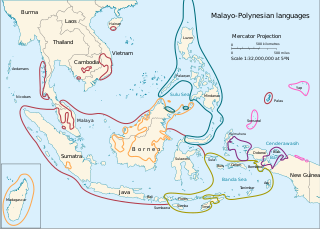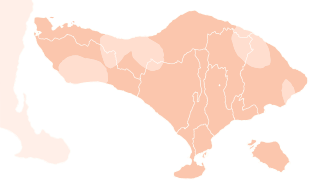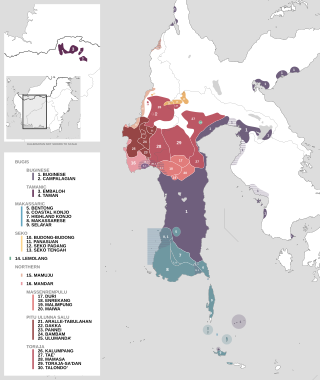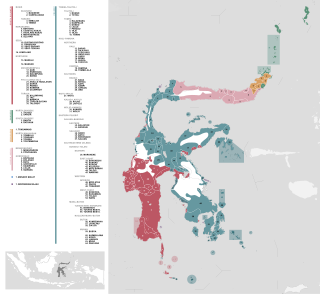Related Research Articles

The Malayo-Polynesian languages are a subgroup of the Austronesian languages, with approximately 385.5 million speakers. The Malayo-Polynesian languages are spoken by the Austronesian peoples outside of Taiwan, in the island nations of Southeast Asia and the Pacific Ocean, with a smaller number in continental Asia in the areas near the Malay Peninsula, with Cambodia, Vietnam and the Chinese island Hainan as the northwest geographic outlier. Malagasy, spoken on the island of Madagascar off the eastern coast of Africa in the Indian Ocean, is the furthest western outlier.

Balinese is an Austronesian language spoken on the Indonesian island of Bali, as well as Northern Nusa Penida, Western Lombok, Southern Sumatra, and Sulawesi. Most Balinese speakers also use Indonesian. The 2000 national census recorded 3.3 million people speakers of Balinese, however the Bali Cultural Agency estimated in 2011 that the number of people still using the Balinese language in their daily lives is under 1 million. The language has been classified as "not endangered" by Glottolog.

Makassarese, sometimes called Makasar, Makassar, or Macassar, is a language of the Makassarese people, spoken in South Sulawesi province of Indonesia. It is a member of the South Sulawesi group of the Austronesian language family, and thus closely related to, among others, Buginese, also known as Bugis. The areas where Makassarese is spoken include the Gowa, Sinjai, Maros, Takalar, Jeneponto, Bantaeng, Pangkajene and Islands, Bulukumba, and Selayar Islands Regencies, and Makassar. Within the Austronesian language family, Makassarese is part of the South Sulawesi language group, although its vocabulary is considered divergent compared to its closest relatives. In 2000, Makassarese had approximately 2.1 million native speakers.
The Gorontalo language is a language spoken in Gorontalo Province, Sulawesi, Indonesia by the Gorontalo people. With around one million speakers, it is a major language of northern Sulawesi.

The Sama–Bajaw languages are a well-established group of languages spoken by the Sama-Bajau peoples of the Philippines, Indonesia, and Malaysia.

The South Sulawesi languages are a subgroup of the Austronesian language family. They are primarily spoken in the Indonesian provinces of South Sulawesi and West Sulawesi, with a small outlying pocket in West Kalimantan.

The Celebic languages are a subgroup of the Austronesian languages spoken on the Indonesian island of Sulawesi, formerly called Celebes. Almost all of the languages spoken in the provinces of Central Sulawesi and Southeast Sulawesi belong to the Celebic group. A few Celebic languages are located in South Sulawesi province. By number of languages, Celebic is the largest subgroup of Austronesian languages on Sulawesi.

On the Indonesian island of Sulawesi, 114 native languages are spoken, all of which belong to the Malayo-Polynesian subgroup of the Austronesian language family. With a total number of 17,200,000 inhabitants, Sulawesi displays a high linguistic diversity when compared with the most densely populated Indonesian island Java, which hosts 4–8 languages spoken by 145,100,000 inhabitants.

Cia-Cia, also known as Buton or Butonese, is an Austronesian language spoken principally around the city of Baubau on the southern tip of Buton island, off the southeast coast of Sulawesi, in Indonesia. It is written using the Latin and Hangul scripts.
The Greater Central Philippine languages are a proposed subgroup of the Austronesian language family, defined by the change of Proto-Malayo-Polynesian *R to *g. They are spoken in the central and southern parts of the Philippines, eastern and western parts of Sabah, Malaysia and in northern Sulawesi, Indonesia. This subgroup was first proposed by Robert Blust (1991) based on lexical and phonological evidence, and is accepted by most specialists in the field.

The Mandarese are an ethnic group in the Indonesian province of West Sulawesi in Sulawesi. The Mandar language belongs to the Northern subgroup of the South Sulawesi languages group of the Malayo-Polynesian branch of the Austronesian language family. The closest language to Mandar is the Toraja-Sa'dan language.

Mamasa Regency is one of the six regencies that make up the West Sulawesi Province, Indonesia, on the island of Sulawesi. It covers a land area of 3,005.88 km2. The population was 140,082 at the 2010 Census and 163,383 at the 2020 Census; the official estimate as at mid 2023 was 170,354. Its capital is the town of Mamasa. The Mamasa people - which is a sub-group of the Toraja people - form the most common ethnic group.
Muna is an Austronesian language spoken principally on the island of Muna as well as North-west Buton Island, off the southeast coast of Sulawesi in Indonesia. The language is well-documented, especially by linguist René van den Berg. In 2010, the language had around 270,000 speakers.
Bambam is an Austronesian language of West Sulawesi, Indonesia. It is spoken in the Mambi and Tabang districts of Mamasa Regency, and in the Matangnga district of Polewali Mandar Regency. Together with Aralle-Tabulahan, Ulumanda', Pannei and Dakka, Bambam belongs to the Pitu Ulunna Salu languages, which form a subbranch within the Northern branch of the South Sulawesi subgroup.
Napu is an Austronesian language spoken in the North Lore district of Central Sulawesi, Indonesia. Together with Bada and Behoa, it belongs to the Badaic subgroup.
Padoe is an Austronesian language of the Celebic branch. It was traditionally spoken in the rolling plains south of Lake Matano in South Sulawesi province. In the 1950s, a portion of the Padoe-speaking population fled to Central Sulawesi to escape the ravages of the Darul Islam / Tentara Islam Indonesia (DI/TII) revolt. In 1991, it was estimated there were 5,000 speakers of Padoe in all locations.
Aralle-Tabulahan is an Austronesian language that belongs to the South Sulawesi subgroup. It is spoken in Mamasa Regency, West Sulawesi, Indonesia.
Pattaeʼ is the language spoken by the Pattaeʼ people, an ethnic group living along the coast in the eastern part of Polewali Mandar Regency, West Sulawesi, Indonesia. Based on lexical similarity and mutual intelligibility, Pattaeʼ has been classified as a dialect of the Mamasa language, but native speakers consider it a separate language.
The Northern South Sulawesi languages are a subgroup of the South Sulawesi languages in the Austronesian language family. They are spoken in an area that stretches from the western peninsula of Sulawesi to the Gulf of Bone. Its most prominent members are Mandar and Toraja.

The Mamasa is an ethnic group residing in Mamasa Regency, West Sulawesi. The Mamasa community is known in districts in Mamasa Regency. The Mamasa people are part of the Toraja sub-people. Mamasa language is similar to Toraja language. The Mamasa people are often referred to as the Toraja Mamasa people.
References
- ↑ Mamasa at Ethnologue (25th ed., 2022)

- ↑ "The Mamasa Language". Sulawesi Language Alliance. Archived from the original on 14 December 2017. Retrieved 14 Dec 2017.
- ↑ Smith, Beverly Kean (1993). A Phonological Reconstruction of Proto-Pitu Ulunna Salu (M.A. thesis). University of Texas at Arlington. OCLC 840034799.